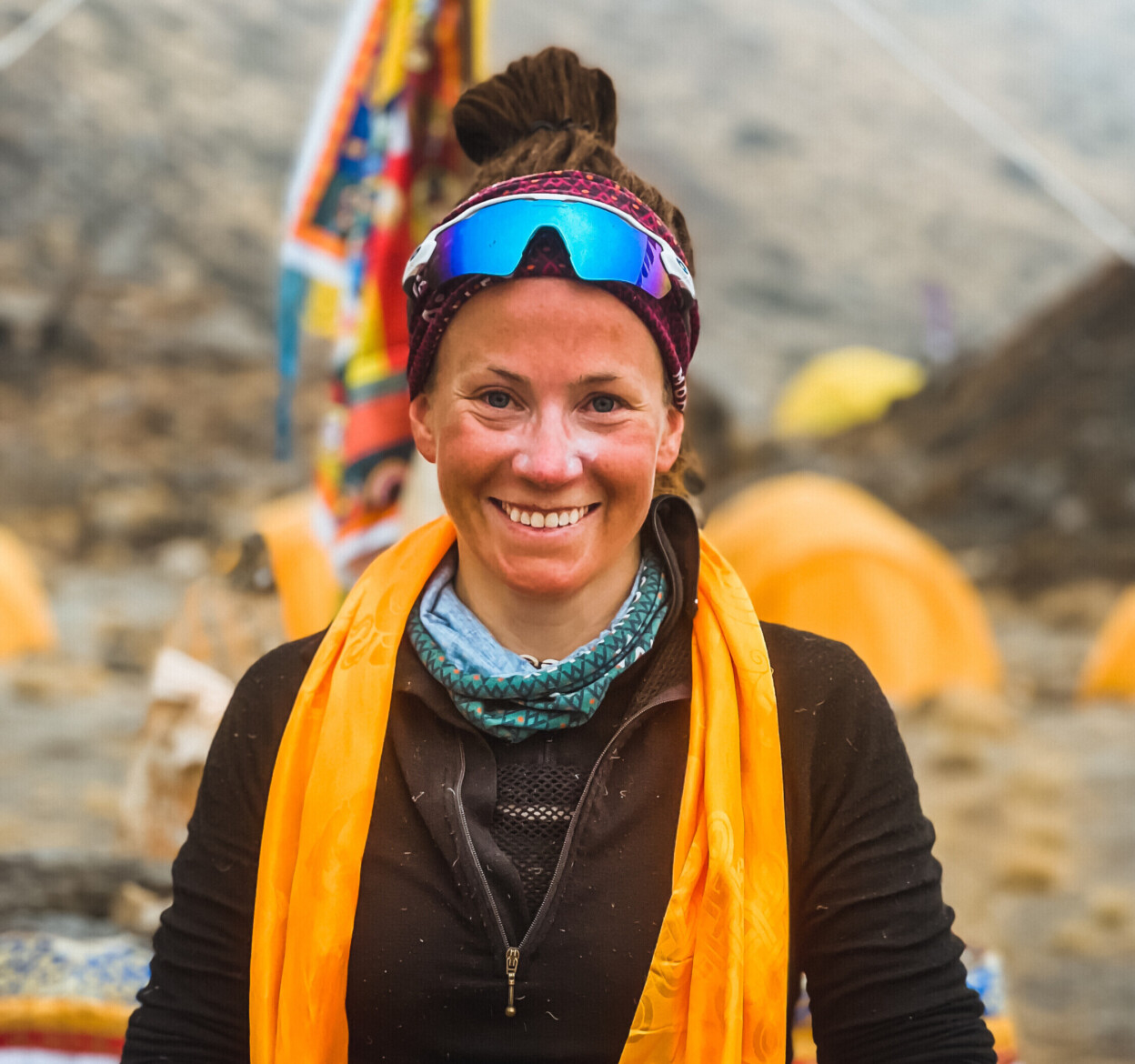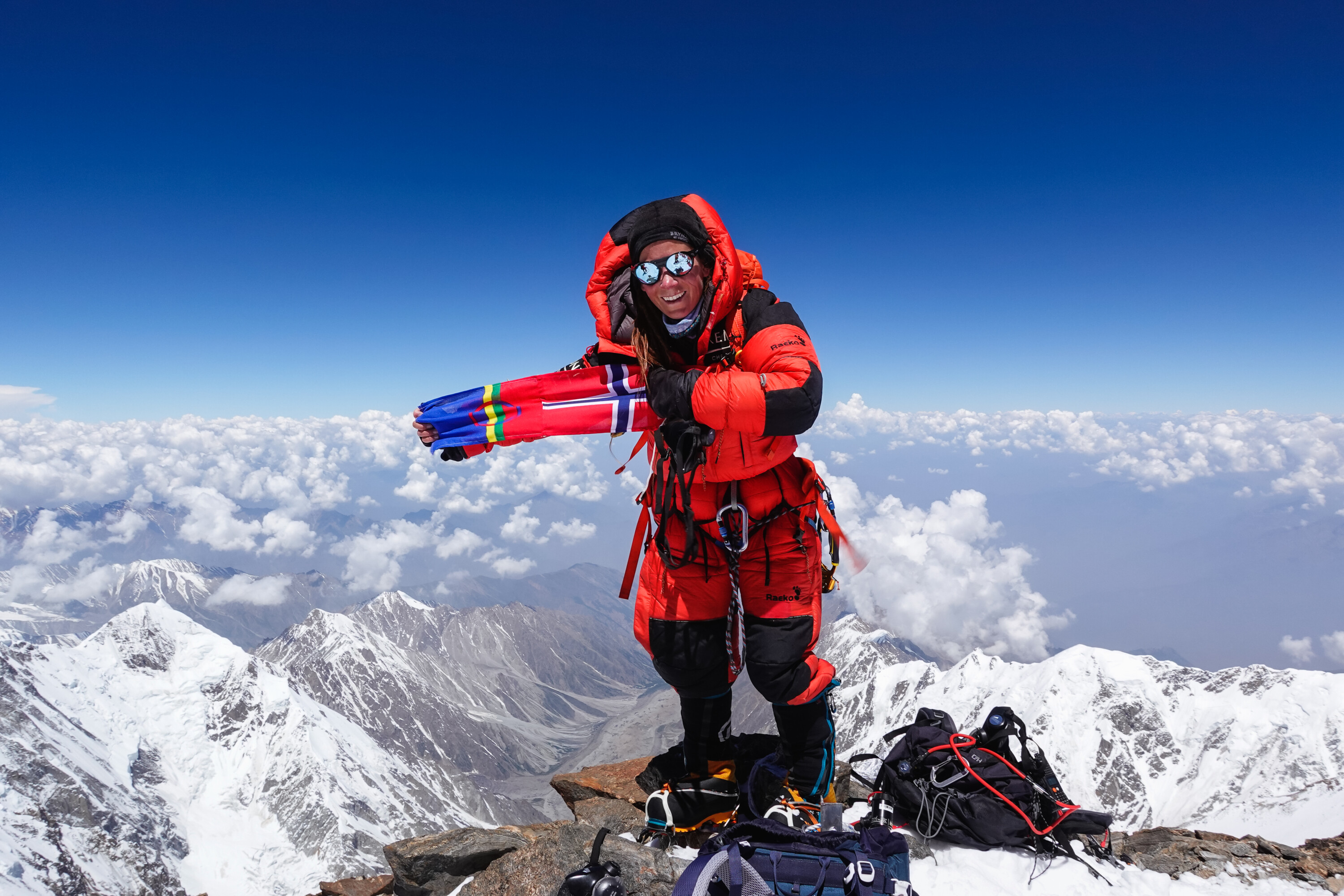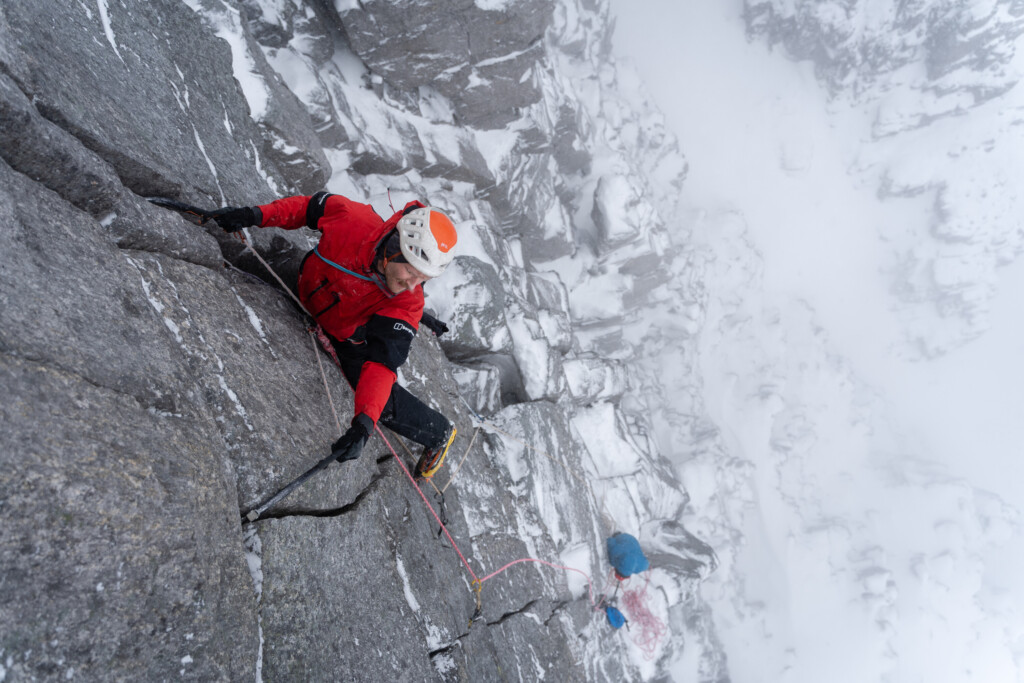With her sights firmly set on the 14 Peaks speed title, Kristin Harila embarked on her latest attempt on the world’s highest summits as part of her She Moves Mountains project earlier this year.
Originally from issue 10 of BASE magazine, I chatted to Kristin just days before she headed to the Himalayas, talking women in high altitude mountaineering, role models, and the importance of reliable kit when taking on the world’s most extreme conditions.
A former professional skier from Norway, Osprey ambassador Kristin Harila climbed her first ‘8,000-er’ at 35. The ascent served as something of a revelation as she unintentionally set a record for the fastest traverse of Everest-Lhotse by a woman. Just 12 months later, she was back on the same mountains, making headlines as she broke multiple records, this time in hot pursuit of Nirmal ‘Nims’ Purja’s six-month 14 Peaks speed title.
Surpassing Purja’s time early in the challenge, she ascended the first six peaks in 29 days, two days quicker than Nims’ 31. Despite such an impressive start, her endeavour was hampered by red tape. When their permit applications to enter Tibet were refused by the Chinese government, Kristin and her team were forced to attempt the ascent of their 13th summit, Cho Oyu, from the lesser-frequented and arguably more dangerous Nepalese side. After 10 anxious days in basecamp, conceding that the treacherous conditions posed too great a threat to the lives of the team, the decision was made to abandon the challenge. The team fell short of just two summits, Cho Oyu and Shishapangma.
Kristin’s determination to take on the 14 Peaks whilst still a relative newcomer to the mountaineering world saw her selling her home in Norway in order to fund her first attempt. Since then, she has unsurprisingly received international media attention and widespread praise, not only for her ambitious nature and staggering speed records, but her pragmatic approach and determination to address the gender imbalance in high-altitude mountaineering for the next generation of women.
I spoke to Kristin upon her return to Norway as she enjoyed some family time and prepared for her next attempt on the 14 Peaks challenge, beginning this time from where she was previously forced to give up. Shortly after we spoke, Kristin summited Shishapangma on the 26th of April 2023. Just one week later, she was standing on the top of Cho Oyu.


You’ve just returned home after calling time on your 14 Peaks attempt. How do you deal with that feeling of being ‘back to reality’, after you’ve spent so long on such an intensive challenge?
Well, I have like six or seven weeks at home this time. I’ve been here since we came back from Cho Oyu and then I leave again in ten days. Before I used to feel quite sad, and I really just wanted to go back. But now every break I have is so busy, without much sleep and a lot of travelling. It’s actually very hectic to be home, so I’m looking forward to going back to the mountains so I can get some rest!
When you’ve had to retire from something that you’ve been so invested in for so long – particularly when it’s for reasons out of your control – how do you begin to process and deal with those feelings?
Well, I didn’t really feel so much because I decided right away to try again. Since then there’s been a lot of work to do and I had lots to focus on like trying to get the permits and the sponsorship and everything sorted out. So I’ve really just been focusing on the future and working on the next step.
And you’re going straight back to try for the record again?
Yes, that’s the plan. Hopefully we will start with Shishapangma and Cho Oyu this time, but we still don’t have the permit. So first we have to get that of course, but either way we need to leave now to start to acclimatise so we will be ready to go.
We need role models to show younger girls that it is possible for them to do it too.


On Everest in 2021, we had five out of five women in the group that summited, and only six of 14 men did the same.
You’re very transparent on your social media, telling both sides of the story, not just the successes. For example, you recently calculated your carbon footprint on the project and shared that with your followers. Why is that honesty and accountability so important to you?
I just like to be open about things. I think it’s good to talk about things that are not so easy to talk about, especially with climate change. Everyone knows that in climbing this or that mountain you have to fly long distances and most of the time with a project like this, you can’t do it without a helicopter. I think it’s better to actually talk about that, to say like, ‘what can we change in the future?’ Because as long as the mountain is there, people will climb. We just have to see if it is possible to climb the mountain in another way, a better way.
And if you’re talking about things like your carbon footprint and acknowledging that, hopefully it’s going to encourage others to think a little bit more about it themselves.
Yeah, and for myself when I started to look at this calculation, I was thinking, ‘ok, these long distance flights have a lot of impact, maybe I can cut one of them’. And I realised that yeah, I actually can. So if we are honest with ourselves and each other we can start to make changes.
We sometimes see images – I think Everest is the one that people will think of immediately – where there are huge quantities of rubbish left behind from the commercial camps, and it’s absolutely mind-blowing that there can be so much in such a seemingly inaccessible place. Do you think mountaineers such as yourself have a responsibility to educate people who aspire to climb these mountains about how they can look after them?
Yeah, for sure. I think we should talk about that too. I actually have a plan to do something with the trash on the mountains after I go for this project again.
I feel like most of the mountains are very clean though, it’s mainly a problem on Everest and K2 where there are more people. If we are going to clean up, we need to have a fresh start because as long as there is trash there, people will throw more. We need a big clean-up, but we also need regulations. I think we need to involve governments and we need to educate, to help people understand. We have a way to go but it is possible to change.
Do you think there needs to be even greater control over the numbers that are summiting Everest and K2, or are there other solutions?
We know how many people are climbing because we know how many permits are issued and we know the statistics of how many made it to the summits too, so I think we need more regulation for the trash mostly. It’s possible to do that by adding on a tax or seeing how much people are carrying down, we could have some points to check what people actually bring off the mountain.
We know that things happen in the mountains like people get sick, people die or they’ve been in an accident and actually can’t take their trash down. And many people will think ‘oh that’s not my trash’. So when we can take trash down we should, and everyone needs to agree to do the same, to help each other when those things happen.


The gender imbalance in high altitude mountaineering is still pretty big, and of course there are complex cultural and historical factors which are a large part of that. How do we go about closing the gap?
I think history is definitely a part of it. It’s always been about men on these expeditions. The first ascents are by men, and the films and the books have been about men. But we are seeing more and more women out there. We’re seeing more and more mothers also being out in the big mountains, and that’s also nice because it has been seen as acceptable for fathers to go in the past, but not for mothers.
I think if you’re going to change it, there’s two important things. One is that we need role models to show younger people, younger girls, that it is possible for them to do it too. And I think we need to make sure that women get equal opportunities when it comes to sponsorship.
Do you think it’s harder for women to get sponsorship?
Yeah, for sure. For some reason some companies feel that we have a lower value. I’m not sure why, it’s probably historical. In Norway for example, we say that we are equal, but the biggest sports brands support mostly men. We need to start by giving female athletes the same amount of funding that we give the men.


I personally believe that women in the outdoors and mountain sports have advantages in our differences from men, in the way that we operate. What advantages do you think women have over men when it comes to high altitude mountaineering?
It’s funny you know, when we were on Everest in 2021, we had five out of five women in the group that summited, and only six of 14 men did the same. All the women came well prepared, both physically and mentally, and the men came like, ‘oh, I can do this’.
I think we are just as strong as they are, and that was kind-of why I started the project. I think it doesn’t always help that we say that we are just as strong, I think if we can show it, it’s much better. I knew Nims had done it in 2019, and I was thinking the best way to change something is to do something that we can easily compare. People have to see themselves represented to feel that they have a place, and that they are equally capable.
And in terms of kit, you favour the women’s-specific fit Osprey Ariel Pro 65 for your expeditions. How important is a properly fitting pack when it comes to high altitude mountaineering?
I have been using Osprey products for many, many years. For me, they are the best. I need to be able to trust and rely on the kit I take with me to the mountains. The pack is so important, it’s almost like one of the most important products that we have, along with the shoes and down suit and maybe the helmet! We wear it a lot and we are going to carry heavy stuff, so it’s important that it is comfortable.
Who inspires you inside and outside the world of mountaineering and why?
Oh, so many in so many different ways. In mountaineering, Melissa Arnot Reid has been really inspiring for me and for many other women and girls. It’s amazing what she’s done. And also other athletes from other sports like Emily Forsberg and Becks Ferry and if I look a little bit into the history of Norway, we have Cecilie Skog – she climbed Everest in 2002.
To get your hands on a copy of BASE magazine in print, subscribe here. It’s FREE, you just pay the postage!
For more inspiring insight from women in adventure, check out this interview with rock and ice royalty, Ines Papert.
Don’t miss a single adventure
Sign up to our free newsletter and get a weekly BASE hit to your inbox
Other posts by this author

Story • Hannah Mitchell • Jul 28, 2023
Reframe, Engage, Create Change
How Arc'teryx's ReBIRD program is engaging consumers with the concept of circularity in the outdoor clothing industry

Story • Hannah Mitchell • Jun 27, 2023
The UK’s Best ‘Almost Wild Camping’ Spots For 2023
Back-to-basics camping and wild vibes... but with a few added comforts

Story • Hannah Mitchell • May 31, 2023
A Greater Purpose: The Arc’teryx Climbing Academy
The Arc'teryx Climbing Academy offers a stepping stone for some, a chance to fine-tune for others, and a welcoming space for all
You might also like

Story • BASE editorial team • Nov 21, 2023
Five Epic UK Climbs You Should Try This Winter
Craving a snowy mountain adventure? Inspired by the Garmin Instinct 2 watch (into which you can directly plan these routes), we've compiled a list of five of the best for winter 2023-24!


Video • BASE editorial team • Jul 21, 2023
Merging Two Lives: The Personal Journey of Hamish Frost
The challenges and triumphs of embracing sexuality in the outdoors

Story • Tom Grant • Feb 23, 2023
Swat Valley Ski School
An impromptu ski lesson during a ski-mountaineering expedition to make the first descent of Falak Sar in northern Pakistan


